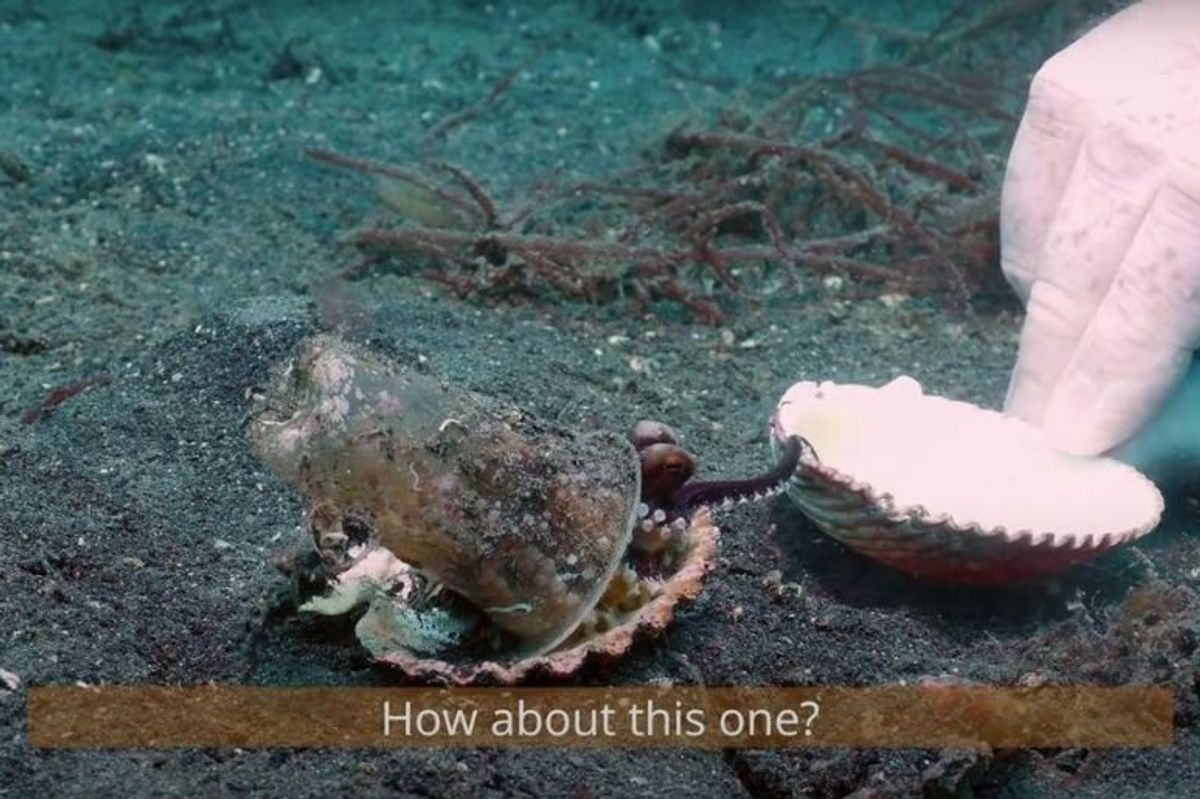Diver convinces a tiny octopus to trade a plastic cup for a shell in Pixar-worthy video
The cup wasn't a safe choice, but the little cephalopod was stubborn.

Plastic is a problem for ocean wildlife.
Sometimes taking care of our beautiful home planet looks like big, broad policies tackling issues like plastic pollution and habitat destruction. And sometimes it looks like taking the time to help one tiny creature stuck in an environmental bind.
In a YouTube video that's been viewed a whopping 20 million times, we see an example of the latter in action as some kind and compassionate divers attempt to convince an octopus to abandon the plastic cup it's using for protection and trade it for a sturdy shell. Pall Sigurdsson has shared dozens of underwater videos on YouTube, but watching this particular video from his dive off the coast of Lembeh, Indonesia, in 2018 almost feels like watching a Pixar short film.

"We spent a whole dive and most of our air saving this octopus from what was bound to be a cruel fate," Sigurdsson wrote in the description of the video.
"The coconut octopus, also known as veined octopus, is born with the instinct to protect itself by creating a mobile home out of coconut or clam shells. This particular individual however has been trapped by their instincts and have made a home out of a plastic cup they found underwater."
It's not just that the flimsy plastic cup didn't provide the octopus adequate protection. Sigurdsson explained that a predator like an eel or a flounder would probably end up swallowing the cup with the octopus in it, likely killing both of them. Plus, even if the octopus abandoned the cup on its own, plastic simply doesn't belong in the ocean.

"We tried for a long time to give it shells hoping that it would trade the shell," he wrote. "Coconut octopus are famous for being very picky about which shells they keep so we had to try with many different shells before it found one to be acceptable."
If you think an octopus in a cup making a decision about shells doesn't sound riveting, just watch:
- YouTubeyoutu.be
The tentacles reaching out to test the weight of each shell, the divers searching for more options to offer it, the suspense of wondering whether the octopus really would abandon its pathetic plastic pollution protection...it's just too much.
Sigurdsson's other underwater videos are also fun to watch. He shared one of another veined octopus who seemed to have no interest in him but became intrigued with his diver friend, Gary. The way it reaches out to touch just the tip of his finger and then shyly retreats feels like such a clear communication with no words being said.
- YouTubewww.youtube.com
Octopuses are far more intelligent than anyone would have guessed before we started studying their behavior in earnest. They are known to solve puzzles, escape complicated mazes and traps, and take apart just about anything. It does make you wonder what these little guys were thinking when these divers were interacting with them. Was it curiosity? Judgment? An attempt at connection between species?
It's funny how one small interaction in one tiny portion of the vast ocean can say so much about us, for better and for worse. Human pollution is an enormous problem and saving one little octopus won't save the world, but it sure gives us hope and motivation to keep trying for the sake of the vast number of creatures that live in the ocean as well as our own.
You can find more underwater videos of ocean wildlife from Pall Sigurdsson on YouTube.
This article originally appeared four years ago.






 Mom hugging crying daughter
Mom hugging crying daughter Dad kissing child on cheek
Dad kissing child on cheek Mom comforting daughter
Mom comforting daughter Prokop Vejdělek, at age 22 and 101
Prokop Vejdělek, at age 22 and 101










 Going from class to class in college is pretty much the same things as hiking.
Going from class to class in college is pretty much the same things as hiking.  View of 2012 rice paddy artwork titled “Hibo Kannon and Acala”.
View of 2012 rice paddy artwork titled “Hibo Kannon and Acala”.